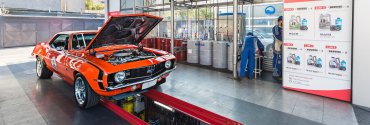
Major oil companies are loosening their grip on the western South American lubricants market, shifting their strategy and allowing regional players to seize more control, according to an industry insider.
There has been a number of strategic changes across the region, principally driven by the [international oil companies] themselves, said Mark McHugh, managing partner at Entoro International LLC, during the ICIS Pan American Base Oils & Lubricants Conference last month. Ten years ago, Shell had operating units in each of the individual countries [of western South America], and effectively it has been a process of divestment since.

Courtesy of COPEC
Chilean-owned COPEC operates 64 quick-lube centers under the Lub name. COPEC is an exclusive Mobil-brand lubricant distributor in western South America after ExxonMobil ceased direct operations in the region.
The western South American market, which McHugh referred to as the Andean region, includes Colombia, Chile, Peru, Venezuela and Ecuador. South America as a whole accounted for seven percent of global lubricant demand in 2017, according to consulting firm Kline & Co.
Colombias lube market is the largest in the region, at what McHugh estimates is approximately 183,000 metric tons per year. Chile comes in at approximately 135,000 t/y, Peru is slightly less at 126,000 t/y and Venezuela and Ecuador lag behind the rest at 51,000 t/y and 49,000 t/y, respectively.
The Shell process was actually moving to macro distributors, which are distributors that are responsible for all the activities of a single market, said McHugh. But its not only Shell or ExxonMobil going through a similar process. In the Andean region now there is zero direct presence of the IOCs. So that has been the fundamental realignment that has been happening.
Shell and BP Castrol have seen the biggest loss in lube market share within the region in the past decade, while ExxonMobil and Chevron-Texaco have plateaued.
While Shells strategy has involved the use of macro distributors, ExxonMobil has arranged an agreement with Compania de Petroleos de Chile for the Chilean-owned gas company to exclusively distribute Mobil-brand lubricant products. COPEC has since expanded throughout the region, including the acquisition of Terpel, one of Colombias dominant players.
This has led to lower market shares across the board since 2009 for Shell, which held significant portions throughout the region in all but Petroleos de Venezuela, S.A.-dominated Venezuela a decade ago, said McHugh. In Colombia, where it was second only to ExxonMobil just 10 years ago, Shell has since slipped from 21 percent of the market to 9 percent, third behind Terpel. And though it has held onto second place in Chile, it has ceded a chunk of its control to local players – from 29 percent to 18 percent. Meanwhile, Shell remains third in Ecuador behind ExxonMobil and Chevron-Texaco, as Valvoline has slowly caught up, but has dropped from 21 percent to 15 percent. In Peru, its share has gone from 23 percent to 18 percent.
BP Castrol has seen its market share tumble in the past decade. BP Castrol pulled out of the industrial lubes segment and moved automotive to an [original equipment manufacturer]-focused strategy, losing a lot of traditional B2C business, McHugh told Lube Report. It has lost approximately half of its market share in Chile and Peru the past 10 years, and is virtually non-existent in Colombia after holding almost 10 percent of the market in 2009.
ExxonMobil has held its place at the top of Chilean, Colombian and Peruvian markets, and sits second in Ecuador. In fact, outside of Venezuela, it has either increased its share or stayed exactly put – from 32 to 38 percent in Chile, 17 to 19 percent in Ecuador, 29 to 32 percent in Peru and 29 percent in Colombia from 2009 to 2018.
Chevron-Texaco has been in steady decline in most places, but has largely held the same position it did in 2009, as the Chevron brand has grown and the Texaco brand has declined. The company has taken a more price-driven approach to the region. Still, it holds most of the market in Ecuador, despite going from 33 percent to 24 percent control of the market. Elsewhere, it has had drops in Peru and Colombia with slight growth in Chile.
Venezuelas perilous PDVSA has all but seized control of its market, mostly due to the countrys economic crisis, which has driven out other players. In the past decade, it has gone from controlling 54 percent of Venezuelas market to controlling 85 percent of it.
In every other western South American country, local competitors as a whole have doubled and even almost tripled their market share. In Colombia, these local players control over 30 percent of the market. In Chile and Ecuador, they have seized over 20 percent, while Perus smaller competitors fall just under the 20 percent mark. Companies like Puma and Petronas have also seen growth in these markets, contributing to the shift.
Overall, IOCs on average have lost more than 20 percent of the market, said McHugh. The only exception is Venezuela where PDVSA had a monopoly until 1996 and has always held a substantial share in the Venezuelan market.